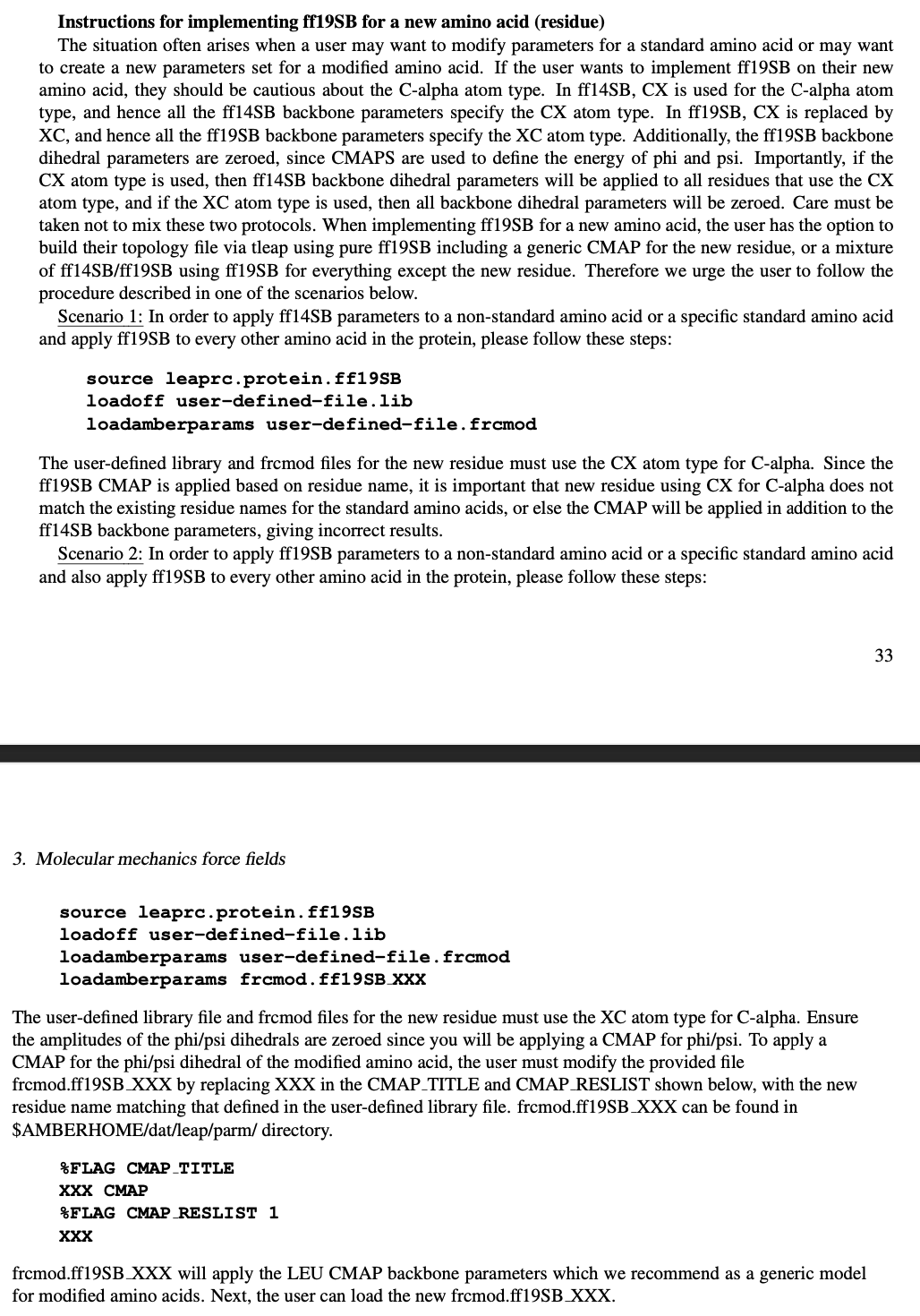Date: Wed, 10 Sep 2025 12:28:44 -0400
I suggest using the ff14SB option here, since ff19SB CMAPs only apply to
non-terminal residues that have phi and psi defined.
carlos
On Wed, Sep 10, 2025 at 8:53 AM Cherry, Kendall <kche.email.unc.edu> wrote:
> Hi Carlos and Charles,
>
> Thank you both for your suggestions. Looking at the lib files that were
> loaded with ff19SB, I found that ASH was listed in amino19.lib but did not
> have a corresponding N-terminal “NASH” residue in aminont12.lib. I plan to
> just define this residue as a nonstandard residue and develop parameters
> for it that way, as I believe the charged N-terminus may be essential for
> accurately modeling this protein.
>
> I noticed in the Amber manual (Amber25, pages 33-34 - screenshot attached)
> that one can either treat the nonstandard residue with ff14SB while the
> rest of the protein is ff19SB, or treat the entire protein, including the
> nonstandard residue, with ff19SB. Is there a benefit to using one or the
> other? It seems like the combination of ff14SB and ff19SB may be easier, as
> I wouldn’t have to zero the dihedral parameters - is this true?
>
> Thank you,
> Kendall Cherry
>
> [image: Screenshot 2025-09-10 at 8.52.56 AM.png]
>
> *From: *Charles-Alexandre Mattelaer <camattelaer01.gmail.com>
> *Date: *Wednesday, September 10, 2025 at 5:43 AM
> *To: *Carlos Simmerling <carlos.simmerling.gmail.com>, AMBER Mailing List
> <amber.ambermd.org>
> *Cc: *Cherry, Kendall <kche.email.unc.edu>
> *Subject: *Re: [AMBER] ASH (protonated Asp) at N terminus missing NH3+
>
> You don't often get email from camattelaer01.gmail.com. Learn why this is
> important <https://aka.ms/LearnAboutSenderIdentification>
> Hi Kendall
>
> A more easy workaround might be connecting your NH to a C and attributing
> it to an ACE residue. This way you cap the ASH with a neutral methyl cap
> and you circumvent the need to define terminal ASH libraries.
>
> Obviously, only an option if the ACE would not interfere with your model
> and property you are trying to analyze.
>
> Kind regards
>
> CA
>
> On Mon, Sep 8, 2025, 17:45 Carlos Simmerling via AMBER <amber.ambermd.org>
> wrote:
>
> it might depend on which force field and libraries you are loading. In
> Amber, you normally convert an N-terminal (or C-) residue name to start
> with "N" (ALA changes to NALA). Then, you need to have library files
> describing that version. It's entirely possible that whoever developed the
> ASH library that you are using did not make the N- and C- terminal
> versions, and also that Leap does not automatically map ASH to a terminal
> residue name. This would lead to you seeing it as just the "internal" ASH
> that was in the library file.
> So - you need an NASH library, and then may need to rename it in the input
> PDB rather than counting on Leap to do that for you.
>
>
> On Mon, Sep 8, 2025 at 11:37 AM Cherry, Kendall via AMBER <
> amber.ambermd.org>
> wrote:
>
> > Hello Amber community,
> >
> > Has anyone used ASH residues at terminal positions before? My protein has
> > an N-terminal Asp and I am trying to simulate it at low pH, so I want
> that
> > Asp to be protonated. When I switch ASP to ASH before passing it into
> > tleap, I noticed that the N-terminal amine only has a single proton on
> it,
> > as if it were part of a backbone amide. It has a negative charge when I
> > look at it using desc within tleap. I am curious if there are parameters
> > for this residue somewhere, or if I should create it as a nonstandard
> > residue.
> >
> > Thank you,
> > Kendall Cherry
> >
> > _______________________________________________
> > AMBER mailing list
> > AMBER.ambermd.org
> > http://lists.ambermd.org/mailman/listinfo/amber
> >
> _______________________________________________
> AMBER mailing list
> AMBER.ambermd.org
> http://lists.ambermd.org/mailman/listinfo/amber
>
>
_______________________________________________
AMBER mailing list
AMBER.ambermd.org
http://lists.ambermd.org/mailman/listinfo/amber

(image/png attachment: Screenshot_2025-09-10_at_8.52.56___AM.png)
